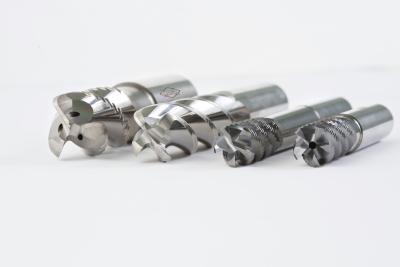
MAPAL is expanding its portfolio in the area of high-performance milling cutters in the OptiMill family for aluminium and steel machining. The full potential of new, powerful machines can be used with the new OptiMill-SPM milling cutters "Rough" and "Finish." They exploit their strengths especially during the machining of structural parts made of aluminium.
High infeed depths, as well as the highest feeds during roughing, are possible with the new OptiMill-SPM-Rough. The reason for this performance is its innovative knurled roughing geometry that ensures the power consumption during machining is significantly lower compared to tools with a straight cutting edge. Furthermore, the heat introduction into the part is minimal due to the excellent plunging characteristics of the tool.
For finishing contours and pocket walls – even at large depths in one pass – MAPAL is announcing the OptiMill-SPM-Finish with newly developed geometry. It operates without problems even with large wrapping – also in the corners with enormous tool contact and a high load, the tool remains stable. The optimally designed cutting edge geometry ensures there is no vibration during the machining. The chip flutes are polished; as a consequence chip removal functions optimally.
The OptiMill-Uni-Wave is the tool of choice if the issue is full slot milling with a groove depth up to 2xD in different materials. Due to its geometry, the highest machining rates are possible. Irrespective of all the advantages of the OptiMill-Uni-Wave, machinists often faced the difficulty that chip removal was not reliable, particularly in steel materials during the machining of slots with a depth ≥ 1.5xD. For this reason, MAPAL now offers the OptiMill-Uni-Wave also with central internal cooling. This feature ensures optimal removal of the chips and longer tool lives. In addition, MAPAL is announcing the OptiMill-Uni-Wave as an extra long version. An efficient solution for roughing even in deep cavities is therefore now available. Despite its length, the new milling cutter is extremely stable due to its conically shaped neck.
Contact Details
Related Glossary Terms
- flutes
flutes
Grooves and spaces in the body of a tool that permit chip removal from, and cutting-fluid application to, the point of cut.
- gang cutting ( milling)
gang cutting ( milling)
Machining with several cutters mounted on a single arbor, generally for simultaneous cutting.
- milling
milling
Machining operation in which metal or other material is removed by applying power to a rotating cutter. In vertical milling, the cutting tool is mounted vertically on the spindle. In horizontal milling, the cutting tool is mounted horizontally, either directly on the spindle or on an arbor. Horizontal milling is further broken down into conventional milling, where the cutter rotates opposite the direction of feed, or “up” into the workpiece; and climb milling, where the cutter rotates in the direction of feed, or “down” into the workpiece. Milling operations include plane or surface milling, endmilling, facemilling, angle milling, form milling and profiling.
- milling cutter
milling cutter
Loosely, any milling tool. Horizontal cutters take the form of plain milling cutters, plain spiral-tooth cutters, helical cutters, side-milling cutters, staggered-tooth side-milling cutters, facemilling cutters, angular cutters, double-angle cutters, convex and concave form-milling cutters, straddle-sprocket cutters, spur-gear cutters, corner-rounding cutters and slitting saws. Vertical cutters use shank-mounted cutting tools, including endmills, T-slot cutters, Woodruff keyseat cutters and dovetail cutters; these may also be used on horizontal mills. See milling.
